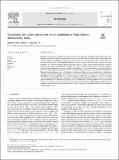| dc.contributor.author | Hui, Rebecca | |
| dc.contributor.author | Wescoat, James | |
| dc.date.accessioned | 2019-08-28T16:37:27Z | |
| dc.date.available | 2019-08-28T16:37:27Z | |
| dc.date.issued | 2019-06 | |
| dc.date.submitted | 2018-01 | |
| dc.identifier.issn | 0016-7185 | |
| dc.identifier.uri | https://hdl.handle.net/1721.1/122024 | |
| dc.description.abstract | Drinking water programs in India treat urban and rural areas separately, generally neglecting the special conditions of settlements referred to as peri-urban or rurban. We show how the historiography of peri-urban areas acquired negative connotations of poor water and sanitation services while rurban places have come to be associated with positive well-disciplined conditions. Previous research on drinking water programs has taken two paths, one of which generates rigorous qualitative case studies that criticize neoliberal policies, while the other employs larger scale quantitative methods to advance neoliberal policy reforms. This paper adopts a hybrid pragmatic approach to visualize strengths and weaknesses of water and sanitation services in urbanizing rural areas of Pune district, Maharashtra. We re-assess demographic definitions of the rural-urban dichotomy in India, distance-based criteria used in Maharashtra, and Census of India water and sanitation data. A combination of field research and GIS mapping identified four main peri-urban patterns in Pune district: (1) megacity fringe; (2) highway corridor development; (3) industrial zones; and (4) block town expansion. We show that while water supply has improved in some rurban areas, sanitation and drainage problems have not kept up. A second pattern of deficiency was observed in transitional towns of 5000 persons. Annually updated water and sanitation datasets at the national and state levels will make this pragmatic combination of GIS mapping and field research approaches valuable for visualizing peri-urban and rurban conditions at the district scale of water governance and planning in India. Keywords: Periurban; Rurban; Drinking water; Sanitation; Pune; Maharashtra; India | en_US |
| dc.language.iso | en | |
| dc.publisher | Elsevier BV | en_US |
| dc.relation.isversionof | http://dx.doi.org/10.1016/j.geoforum.2018.01.008 | en_US |
| dc.rights | Creative Commons Attribution-NonCommercial-NoDerivs License | en_US |
| dc.rights.uri | http://creativecommons.org/licenses/by-nc-nd/4.0/ | en_US |
| dc.source | Elsevier | en_US |
| dc.title | Visualizing peri-urban and rurban water conditions in Pune district, Maharashtra, India | en_US |
| dc.type | Article | en_US |
| dc.identifier.citation | Hui, Rebecca and James L. Wescoat, Jr. "Visualizing peri-urban and ryrban water conditions in Pune district, Maharashtra, India." Geoforum 102 (June 2019): 255-266 © 2018 The Author(s) | en_US |
| dc.contributor.department | Massachusetts Institute of Technology. School of Architecture and Planning | en_US |
| dc.contributor.department | Massachusetts Institute of Technology. Department of Urban Studies and Planning | en_US |
| dc.relation.journal | Geoforum | en_US |
| dc.eprint.version | Final published version | en_US |
| dc.type.uri | http://purl.org/eprint/type/JournalArticle | en_US |
| eprint.status | http://purl.org/eprint/status/PeerReviewed | en_US |
| dc.date.updated | 2019-08-07T14:33:22Z | |
| dspace.date.submission | 2019-08-07T14:33:23Z | |
| mit.journal.volume | 102 | en_US |
